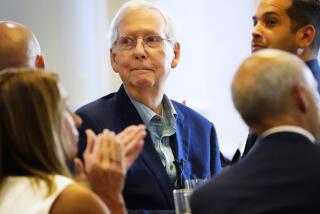‘The Hypochondriacs’ by Brian Dillon
One of the gags in Woody Allen’s “Whatever Works” involves Allen’s neurotic alter ego (Larry David) bemoaning an ulcer. When his ridiculously young girlfriend (Evan Rachel Wood) reminds him that he doesn’t have an ulcer, he retorts, “I didn’t say I don’t have an ulcer -- I said they haven’t found one yet.”
That, in a nutshell, is hypochondria today: health anxiety, inflamed by fear of illness and death, intransigent even in the face of professional reassurance, and often exacerbated by partial or incorrect information, frequently gleaned from the Internet.
Brian Dillon has firsthand familiarity with the sort of angst that afflicts the Woody Allens and other “worried well” of this world -- and he knows it can be no laughing matter.
His first book, “In the Dark Room,” winner of the 2006 Irish Book Award for nonfiction, is a memoir chronicling his parents’ early deaths, which heightened his concern with his own health during late adolescence and early adulthood: “I became convinced that I would be the next to die, and began to inter- pret every stray discomfort as a sign of the dread dis- ease that would take me away.”
In “The Hypochondriacs: Nine Tormented Lives,” Dillon expands his inquiry to examine the relationship between real and imagined illness as it affected nine prominent artists and writers, ranging from James Boswell in the 18th century to Andy Warhol in the 20th.
The result is an intriguing, suavely written blend of medical history and literary criticism, a book that adds to the growing (or metastasizing) field of pathological biography.
Be warned, however, that Dillon’s subjects don’t neatly fit our modern notion of hypochondria as neurosis. Alice James, Charles Darwin and Marcel Proust were all chronic invalids who obsessed about their health and defined themselves through their illnesses. But they also suffered real pain and organic, if undiagnosed, ailments.
Why call them hypochondriacs? Because, as Dillon explains, the definition of hypochondria has mutated over the years, from an amorphous array of physical ailments to a largely mental, neurotic affliction.
Dillon makes a strong case that protracted illness, whether real or imaginary, enabled many of these artists to “retreat from extraneous duty” and escape into their creative work. In a sense, he notes, “hypochondria was both an illness and a cure: the catalyst or condition that allowed the artist or thinker to function . . . a kind of calling, almost a vocation, that structured a life.”
For Charlotte Brontë, attacks of what she called hypochondria, but we might characterize as depressive breakdowns, helped abbreviate the teaching career she loathed -- in large part because it left her so little time to indulge her imagination or write -- and two stints studying in Brussels.
Once back home, Brontë channeled her distress into her writing. Dillon sheds new light on two of her lesser novels, “The Professor” and “Villette,” by examining them in relation to their author’s health issues.
Two of Dillon’s subjects, Darwin and Florence Nightingale, retreated to their sickbeds after seminal forays into the wider world -- to the Galapagos for Darwin, and to the unsanitary Crimean hospital wards for Nightingale -- that provided material for their lives’ work.
It is now thought that Nightingale, who was afflicted for years with insomnia, headaches, palpitations, excruciating back pain and no appetite -- Dillon calls her “the most ambitious of the high Victorian hypochondriacs” -- may have contracted brucellosis in the Crimea and possibly also suffered from post-traumatic stress syndrome. Yet she successfully agitated for health reforms even from her sickbed and lived to 90.
The source of Darwin’s intestinal and other ills may well have been a parasite, but he cultivated his invalidism as a sort of useful eccentricity, focusing on his physical discomforts to a neurotic degree even while he produced “The Origin of Species.” Like others in the book, he tried numerous far-fetched cures, including torturous water treatments.
Several of Dillon’s subjects suffered from real illnesses that they exacerbated with a combination of self-neglect and self-medication.
Proust experienced his first asthma attack before age 10, but “he seems to have embraced weakness” with stoic resignation and inadequate diet, air, light, exercise, heat and medical supervision -- “a submission to whim and routine that was in itself . . . a kind of pathology.”
One of the more engaging cases Dillon considers is that of pianist Glenn Gould, who, a few years before he stopped giving live performances altogether in 1964, spent four weeks in a full body cast and subjected himself to 117 orthopedic and chiropractic treatments to treat what he claimed was an inflammation resulting from a Steinway concert technician’s unwelcome pat on the shoulder.
Like many of the hypochondriacs in this fascinating but at times enervating book, Gould was a control freak disinterested in food, obsessed with his physical comfort and distrustful of doctors.
Another common characteristic that Dillon doesn’t stress is hypersensitivity -- in Gould’s case, to touch, bright colors and cold -- an underlying condition that may have predisposed these high achievers toward both hypochondria and art.
Reading Dillon’s account of the battles they fought with their minds, bodies and imaginations, one doesn’t envy their heightened sensibilities.
McAlpin reviews books for NPR.org and the Christian Science Monitor, among other publications.
More to Read
Sign up for our Book Club newsletter
Get the latest news, events and more from the Los Angeles Times Book Club, and help us get L.A. reading and talking.
You may occasionally receive promotional content from the Los Angeles Times.






